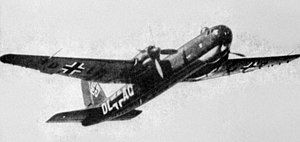He 177
| He 177 | |
|---|---|
 |
|
| The second He 177A-0 production prototype (A-02) with broad-bladed propellers, bearing radio code "DL+AQ" | |
| Role | Long-range heavy bomber |
| Manufacturer |
Heinkel Flugzeugwerke Licensed to Arado |
| Designer | Siegfried Günter |
| First flight | November 1939 |
| Introduction | 1942 |
| Retired | 1945 |
| Primary user | Luftwaffe |
| Number built | 1,169 |
| Variants |
Heinkel He 274 Heinkel He 277 Amerika Bomber |
The Heinkel He 177 Greif ("griffin")is a large long-range heavy bomber flown by the Luftwaffe during World War II. In general terms, the He 177 had payload/range capability similar to strategic bombers in the USAAF and RAF, although it had much higher figures for its cruising and maximum speeds.
Designed to a 1936 requirement known as Bomber A, the aircraft was originally intended to be a purely strategic bomber intended to support a long-term bombing campaign against Soviet industry in the Urals. During the design phase, Luftwaffe doctrine came to stress — unrealistically, for a 30-meter (100 ft) wingspan-class bomber airframe — the use of moderate-angle dive bombing in order to improve accuracy, and the design was extensively modified to allow shallow-angle "glide bombing". This change, along with the demand that it use only two fully nacelled "power system" engines, required to each be of over 1,500 kW (2,000 PS) output levels apiece to allegedly reduce drag for the initially demanded "glide bombing" capability, created numerous problems for the aircraft. Luftwaffe aircrew nicknamed it the Luftwaffenfeuerzeug ("Luftwaffe's lighter") or the "Flaming Coffin" due to the serious engine problems on initial versions. Many of these stemmed from the power plants' inadequately-designed and poorly maintained installation in their wing nacelles, which caused cooling and ventilation problems that were never completely solved.
The type eventually matured into a usable design, but too late in the war to play an important role. It was built and used in some numbers, especially on the Eastern Front where its range was particularly useful. It is noted for its use in mass raids on Velikiye Luki in 1944, one of the few late-war heavy bombing efforts by the Luftwaffe. It saw considerably less use on the Western Front, although it played a role during the late-war Operation Steinbock, or "baby blitz", against the UK.
...
Wikipedia
